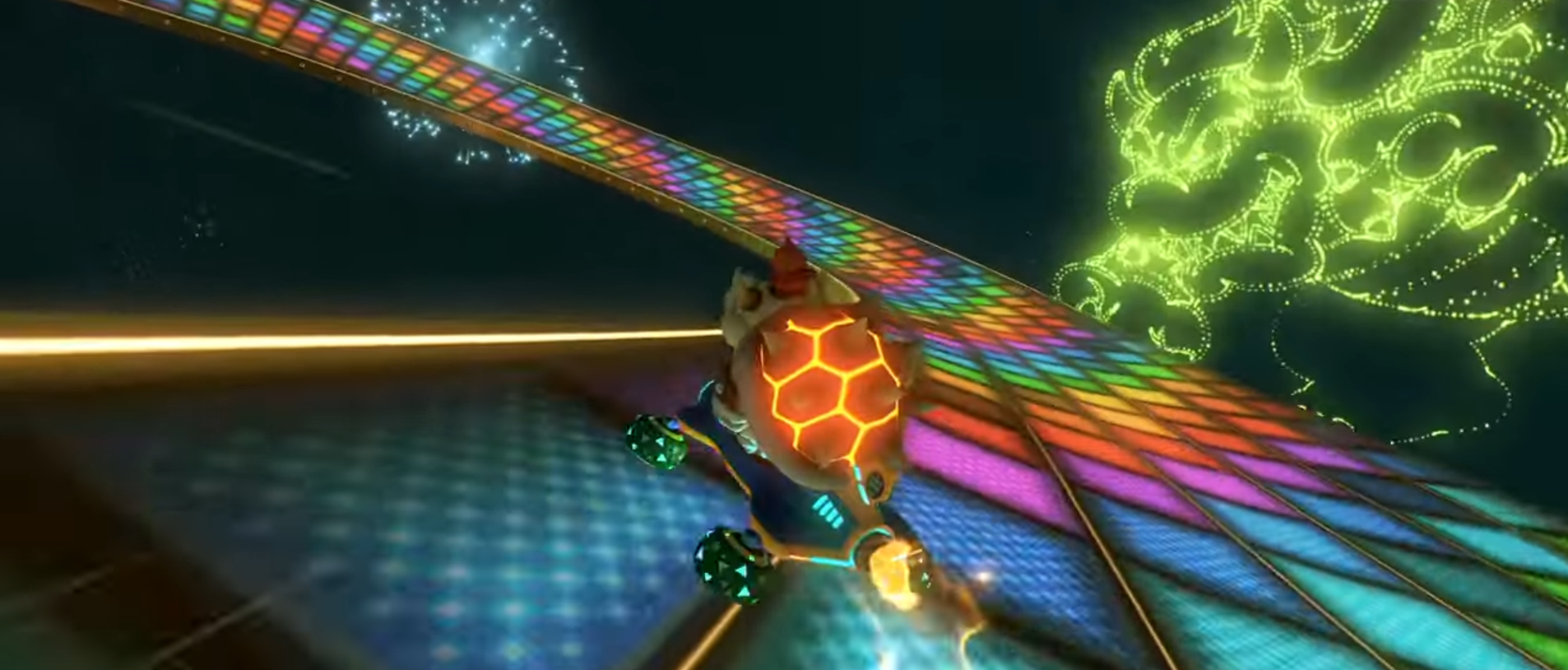When I first started playing Mario Kart competitively, it wasn’t to play MKU, or compete in any form of online tournament or league. It was Christmas of 2014, and I had just been gifted a Wii U along with a handful of games, Mario Kart 8 being the one I was particularly excited for.
Why? Well, the most obvious answer was that I’ve been a Mario Kart nut since I was a kid, but there was something else that drew me to this particular entry. I won’t lie: the graphics were beautiful at the time, but I had a mission in mind: to score a world record.
Rewind one year. I was bored of Mario Golf: World Tour and had borrowed my brother’s copy of MK7. The Grand Prix were child’s play to me; getting through them was a rather mundane exercise in which the main purpose was to become acquainted with the tracks themselves. Naturally, I ended up finishing with SNES Rainbow Road, and despite the simplicity of its design, the starry sky with the 3D effect on, the risk of falling off (and the consequent reward of success), and the sheer speed of rushing through the course signaled to me that I had unfinished business.
I continued to play the game’s final track in Time Trial mode, something I had toyed around with in past games, but viewed as “practice” for Grand Prix and didn’t see too much value in the offering. My experience with MK7’s GP mode, though, was the wake-up call I needed to start playing competitively. I was already developing a competitive mindset by the time I first picked up MK7; I had realized my skill in World Tour’s online tournaments, consistently placing among the very top positions almost every time. What surprised me quite a bit, was just how addicting Time Trials became, almost instantly. I got bit by a bug and still have a bit of the itch even to this day.
My first sense of accomplishment was breaking the 1:20 mark. This sort of barrier is most often called a “sub”, as in “sub-1:20”, which in this case simply means a time under a minute and twenty seconds. It was a humble accomplishment, for I realized there was still a lot to go, and that there were most definitely many people who had clocked much better times. So I did a quick Google search for the world record on the track, and discovered what would serve as my foray into the global MK community.
My discovery was mkwrs.com, a site that lists up-to-date world records for major categories in the mainline Mario Kart games. I would quickly find the then-current world record of 1:12.991 by Mr.L, verified now by the site’s history-keeping but which still rings a loud bell when I see it. The shaky camerawork in the linked video was typical of the time, and a nostalgic hallmark of “classic” MK competition, but it did present many tips, including the best character and kart to use, and driving techniques that would allow me to hone my skills. And hone them I did indeed: by the end of the year I would go on to hit 1:16.267, not once, but actually twice, before beating it several times in the coming years.
I’ll omit the remainder of my story, other than tie in what I said at the start: given my acute fondness for time trialing MK7, my goal for Mario Kart 8 was one task, albeit a bold one: to score my very own world record.
But there’s a more fundamental question which I haven’t answered. What makes time trials (a form of speedrunning, which I will get into), so fun? It’s a repetitive and counterintuitive way of playing the game, relying on frequent restarts, and at times aggravating. Why don’t we start with a little history lesson?
Competition at Its Core
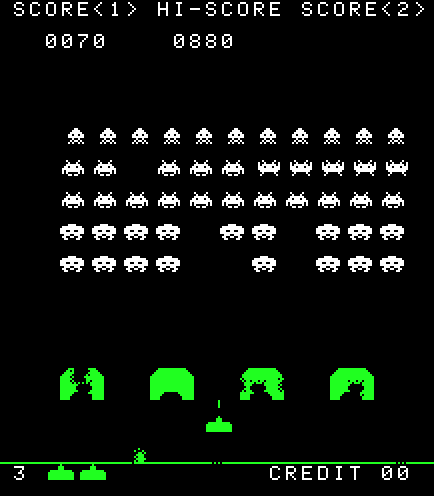
Speedrunning is inherently competitive, due to the sharing of records with other players (as well as tips and advice). That said, it’s only a specific form of competition, so let’s talk about video game competitions in a more general sense for perspective.
The renowned arcade hit Space Invaders is often considered the first video game which incited widespread competition, chiefly due to the fact that it was the first game which saved high scores as a programmed feature. This was a natural adoption from pinball machines, which were one precursor to arcade games.
Since each arcade unit stored its own high score specific to that machine, players had no idea what scores people in other locations had achieved. This changed with the introduction of Twin Galaxies, which Walter Day founded by traveling to various cities around America, compiling and publishing a list of the best scores of various popular arcade games.
There’s one word used above that you probably glossed over, and that’s “high” in “high score”. This stands in stark contrast with speedrunning, in which the aim is to achieve the lowest score. Games like golf also share this distinction, though in the case of a speedrun, the variable is time, which has real-world significance, and not merely an artificial construct.
“High” scores mark the opposite side of the coin as “low” ones, but there’s more to it than just the size of the numbers themselves. A lot of it has to do with the nature of the game itself. Games that favor high scores typically get harder as players progress, making racking up points a test of increasing skill. On the other hand, some games notably lack this characteristic in such a way that skilled players can play indefinitely due to their talent. As an example, the world record for the arcade game Asteroids was set over a grueling 58-hour marathon, where the determined John McAllister would rack up maximum lives, take a quick break as he suffered damage, only to return and reclaim the lives in what seemed like a perpetual endeavor.
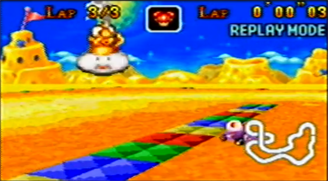
Low scores are completely different. In the case of a speedrun, there is an inherent lower bound on the time someone can achieve, although typically an exact number is not known. Since us humans always see a need to improve, and feel there’s nothing to do after perfecting the game, some communities swear a silent oath not to analyze the game to the point where a definitive limit can be determined. This is observed to some degree in the SNES Super Mario Kart community, where tool-assisted speedruns (TASes) are not nearly as common as you might expect.
On the other hand, perfect runs are certainly achieved in many cases: the most well-known example in the MK world is Super Circuit’s Cheese Land 0″03 lap, made possible by a glitch that tends to bemuse the uninitiated. Others exist, and the concept is referred to as a “maxed” time, which seems to be a misnomer, but I like to reconcile the word choice as meaning “having attained the maximum possible skill.” In most circumstances, though, maxing a time is humanly impossible, or almost so, and the world record will slowly approach the limit, but likely never reach it.
Speedrunning Emerges
Traveling in order to source records is nothing short of an antiquated practice nowadays, thanks to the internet. That invention is exactly what ignited speedrunning as a new way of playing games, since players could much more easily share knowledge with other experts and compete with each other.
Super Mario Kart shared with other games of the time the distinction of playing a vanguard role in the development of competitive speedrunning, which was of course natural, seeing as it was one of the more popular games when the first web browser was introduced in 1993 (SMK was released a year prior). We also can’t turn a blind eye to the game’s built-in timer, which provides an easy way to measure records accurately.
The trend was continued with the release of Mario Kart 64, and that game, along with increasing internet adoption in many parts of the world, led to Mario Kart assuming a seemingly permanent place in speedrunning culture.
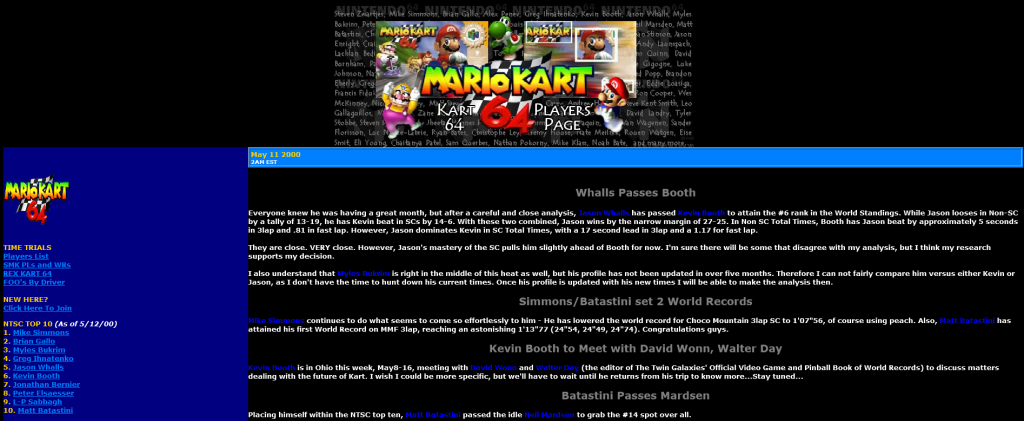
There were a few notable sites highlighting MK64 records in its early days (supposedly “over 40”), such as REX’s MK64 Rankings, although the only one to stand the test of time was the Mario Kart Players’ Page, which still exists at mariokart64.com, and remains the go-to destination for time trial competition in retro MKs. Having been founded over 24 years ago, it’s nothing short of remarkable for a community-run site to last so long. A detail I left out in the introduction to this article is that it was this site that got me connected with the Mario Kart community, thanks to its forums and my joining of a few Skype groups where I got to connect with other players, some of which I still am very close with even now.
Check Your Definition
I’ve mainly been talking about time trials so far, but I’ll admit I’m presenting a view contrary to what most players familiar with the Mario Kart scene would expect. In the context of MK specifically, “speedrun” most often refers to Grand Prix speedruns, not so much time trials.
My view is that both activities are by definition “speedruns”, because the purpose in both is to complete an objective in the fastest possible time. That said, I accept the way we use our words here, not only because it’s more practical to be able to distinguish easily between the two modes in conversation, but also because of another argument.
Let’s look at one of the most famous speedrunning games, Super Mario Bros. A launch title for the NES, Nintendo wanted to challenge players by having them run through a sequence of 32 levels in order to complete the game. Of course, we all know about the Warp Zones, but I would imagine Nintendo didn’t intend for most players to use or find them. (Secrets like these were often implemented as a means to sell tips through official magazines and even paid phone hotlines.) The intent is important here. Nintendo also didn’t intend the goal of the game to be to completed as fast as possible; they provided other mechanisms to claim accomplishment with, such as a score counter (which doesn’t actually mean too much), and also a “hard mode” which is unlocked after completing the game once. Disagreeing in this sense is the design of Time Trials, where the whole point is to finish the level in as fast a time as you can.
Grand Prix runs are more like Super Mario Bros. than Time Trials if looked at from the above perspective, since the intended purpose of Grand Prix is to score the most points, claim the trophies, and in most games, get a good “rating” (stars or letter ratings). A few MK games store your best total times achieved in Grand Prix mode, but this is not the norm for the series.
Now you can see what I’m getting at. Speedrunning emerged as a different way to play games, in a way that often challenged the intended goal of the game. Under this philosophy, time trials aren’t pure speedruns, while Grand Prix speedruns are, hence the distinction when players talking about racing Mario Kart.
A Briefly Controversial Revolution
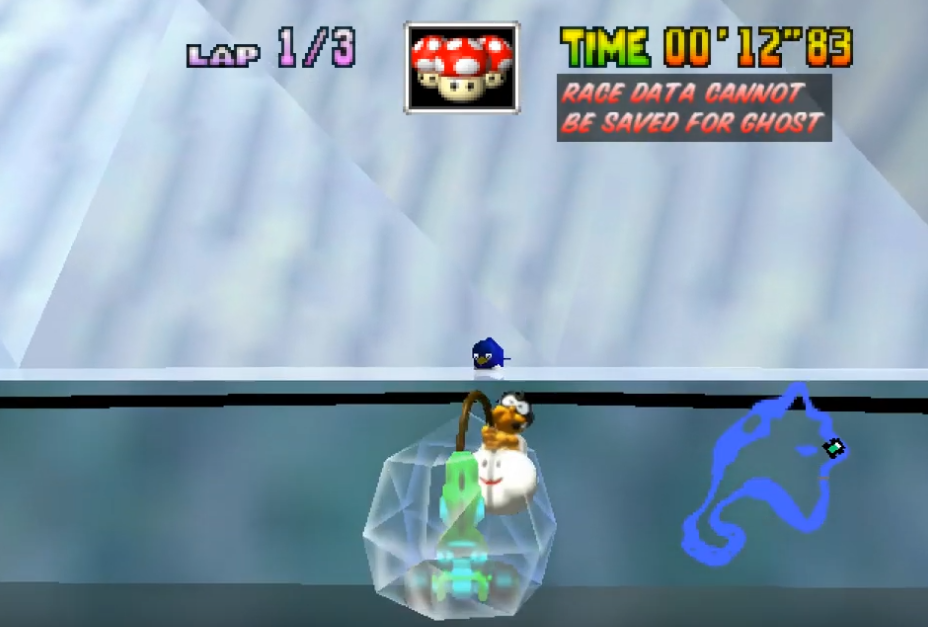
In 2003, the release of a particular video of a Super Mario Bros. 3 speedrun, by the player “Morimoto”, generated a lot of attention. The incredible performance seemed superhuman, and it was: it was the video that sparked the tool-assisted speedrun scene, where special devices are used to complete a run faster than any human likely could.
These tools are usually emulators, computer programs which simulate the operation of console hardware. Earlier TASes were usually made with hacks that slowed the game played on a real console, but emulators provide far more capabilities, allowing for rewinding and manual entry of individual inputs. (Disclaimer: emulators, but more specifically the practice of downloading games off the internet to use, have been at odds with copyright laws, but so far no meaningful measures have been put into place to prohibit them entirely, and so TAS communities still thrive.)
The controversy arose because it became evident that a video alone isn’t enough to prove the legitimacy of a human speedrun (called a real-time attack, or RTA). While in some games visual clues can signal the use of an emulator, this often isn’t the case. Typically a variety of methods are employed, some “soft” (such as analyzing statistics on player progress and game events, and establishing trust with top players), some much “harder” (like using programmed game features including ghost sharing, or analyzing inputs to catch anything physically impossible).
Nowadays, TASing plays a key role in the overall speedrunning scene. By conducting tests in a way that is more akin to a science than entertainment, new insights can be revealed on the game’s inner workings, and reveal faster methods of completing a run—these contributions are used by players attempting RTAs to push their game further.
At times, innovations discovered using TAS techniques can turn the game on its head and then some. A notable recent example is what happened with Mario Kart 64 over the the past year or so: new shortcuts (glitches) were given a place in time trialing on 7 of the game’s tracks, with an eighth demonstrated in a TAS but yet to be performed in an RTA world record run. As a result, records were smashed over and over, and top streamers gathered plenty of attention from the public as they “broke” the game in several new ways throughout the year.
Such glitches also have a place in Grand Prix speedruns. While Mario Kart 8 doesn’t have any known glitches that provide a benefit to the player (aside from physics quirks such as “firehopping” and the effect of using different controllers in the Wii U version, and “motion gliders” in Deluxe), past MK games are chock-full of them, and are exploited to their fullest potential in speedruns of games such as MK64 and MKWii. In many ways, they generate a lot of public interest even with casual viewers, who completely eat up YouTubers’ and streamers’ content that feature extensive use of them.
Speedrunning Today
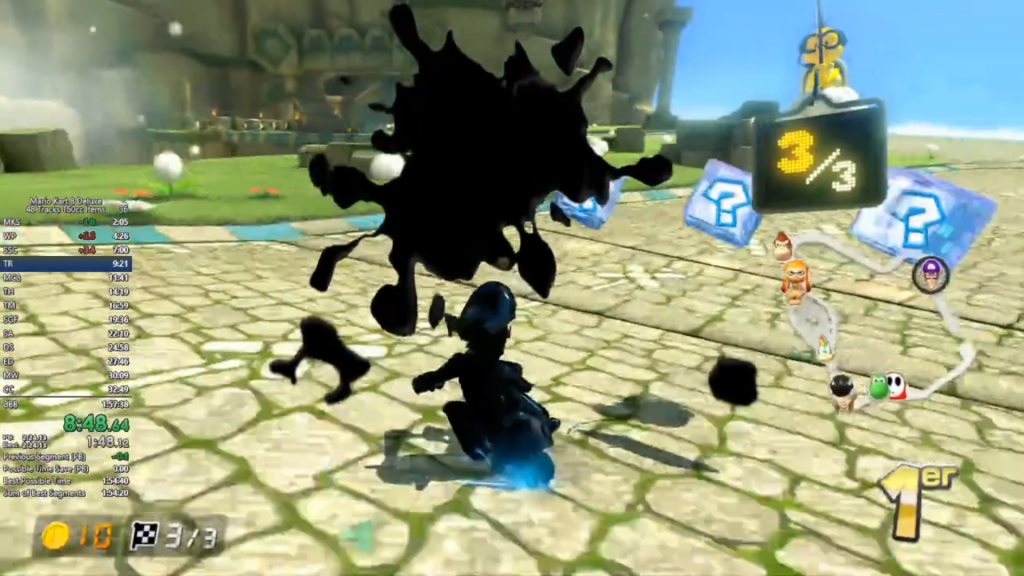
Speedrunning in modern times is a bit different socially than in the past, and even compared to modern tournament-based competitions. As far as Mario Kart goes, players in competitions such as MKU often don’t stream, and those that do almost exclusively do it for a few friends and generally wouldn’t be considered hardcore streamers, at least not judging by that specific content.
Speedrunning has completely different customs. Streaming attempts is the norm, and often expected for higher-level gameplay. While a score in MKU or another tournament can be backed up by the other players in the room, a single-player game requires harder proof standards, of which streaming is one of the most effective and veracious forms.
Consequently, social interactions are quite different: while players in tournaments communicate with their team during the game, streamers will interact with viewers through chat, talking while they type messages which can be answered by the player (or just ignored altogether). At times, friends will be in a call with the streamer, and serve as “guests” on the channel, often for fun, but also sometimes to collaborate with other players for cross-promotion. The best content creators can make significant sums of money through their efforts, which is an additional incentive for some to keep improving their game.
LANs, or local, in-person tournaments, are hard to translate to the context of speedrunning. Sometimes “one-try” speedrunning tournaments are held at small venues (as well as online), but they usually are a part of a larger event where more traditional tournament formats are hosted.
That said, there is a definite place for speedrunning at more public venues. The semiannual Games Done Quick marathons (currently held completely online due to COVID-19 concerns) are an exemplary case, raising millions of dollars per event for charities, and feature top players from a vast array of games performing both traditional runs and quirky challenges, topped off with colorful commentary and a Twitch stream in which viewers are given the opportunity to interact with the event.
As for community involvement in Mario Kart speedrunning, most communication today takes place in various Discord community servers, which are usually separated based on game and interest (some more specific than others). These are the best places to meet other like-minded fans of the series and learn new ways to level up your game.

For Mario Kart 8 Deluxe specifically, there are two main sites which serve as the go-to spot for speedrunning records: speedrun.com for Grand Prix runs (as well as some miscellaneous categories), and MKLeaderboards for time trials. The former is a large project featuring basically any game you could think someone might possibly speedrun, while MKLeaderboards is a community project also featuring MKWii and 7. There are other sites as well, but these are the most prominent today, and are among the most reputable.
With the appeal of online multiplayer in MK8DX, speedrunning has taken a backseat compared to the first several games in the series. That said, speedrunning by no means holds an anachronistic existence in a world of online competition. Practicing individual tracks is a great way to prepare for tournament matches, letting players focus on improving their game systematically and without time constraints, rather than during the pressure of an intense online competition. Grand Prix runs simulate online matches in a unique way, with the tracks only appearing once each, and fostering development of competitors’ “running” games as they try to break ahead of the AI to get to the finish in blazing time. Additional, more casual, categories for speedruns and time trials have been created that prohibit the use of items and mushrooms, which are meant to let runners focus on pure technical driving instead of relying on items.
Speedrunning isn’t for everyone, but it’s a pillar of the Mario Kart community, and provides a unique way to experience the game. Tournaments certainly have winners, but if you want to maintain your champion status going forward, you’ll need to win the next one as well. The allure of speedrunning is often the dream of hitting a world record—a coveted achievement most will not reach. That world record may not last long (when I finally hit mine, it lasted no more than 5 minutes), but there’s the potential for it to last months, years, or in some cases, into the decades. No matter the circumstance, your name will be permanently etched into the history books when you get one. And on top of that, some players aspire to reach higher positions on overall rankings (my favored approach), or just thrive off the feeling of setting a new personal record or milestone. Whatever the case may be, it’s an experience worth trying.

